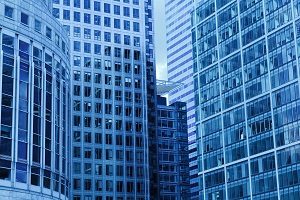
Exposure Spotlight: Office Buildings
There are many types of commercial office buildings, with each having a variety of potential pollution exposures. Depending on where the building is located and its age, there may be different air handling equipment, maintenance chemicals, water run-off, or building materials. Pollution releases from any of these common activities may result in claims against insureds for bodily injury, property damage, and cleanup costs.
Mold or off-gassing from furniture or carpet, vapors from copying machines, asbestos fibers, bacteria, and carbon monoxide from lower floor parking garages that are not ventilated properly—these are just a handful of the many potential pollution problems that can occur.
Some environmental concerns for office buildings may include:
Office activities
- “Sick Building Syndrome” – an increase in energy efficient buildings that have more controlled airflow and less ventilation has resulted in an increased incidence of carbon monoxide build up, mold infestation, and general sick building syndrome, where a large number of people who work or visit the same building begin to experience similar health issues such as respiratory problems or allergic reactions.
- Ultra-fine particle emissions (including nanoparticles and ozone) from printers, faxes, and copy machines may cause indoor air quality problems. Methyl alcohols, a constituent of ink toner, has been found to cause eye and skin irritation.
Waste management
- Waste from maintenance or renovation activities may be disposed of improperly which could result in property damage, cleanup costs, or bodily injury claims against the generator of the waste (i.e. office building owner or manager).
- Corroded sewer pipes from waste drains can spill hazardous materials from waste discharges, affecting soil or groundwater.
- Waste disposal activities of tenants that may be unknown to the owners or managers of the office building, such as wastewater from processing photos or disposal of pharmaceuticals down drains. Often, companies will have samples of the products they sell in commercial office buildings which may not be disposed of properly, such as paints, cleaners, solvents, food products, gas cylinders, etc.
Facility maintenance
- Solvents, paint strippers, ammonia, and cleansers are used by custodial staff for cleaning and maintaining office spaces which can be hazardous to office workers and cause indoor air quality issues within the building if they are spilled or used improperly.
- Insecticides and pesticides used for lawn care or indoors are often persistent. They can be highly toxic if used inadvertently in large quantities.
- Improper management of asbestos or lead paint can lead to particulates in the air which may be health hazards or toxic.
- Poorly maintained ventilation systems or water intrusion may lead to mold or microbial matter, causing unhealthy indoor air quality. This could lead to allergic reactions, infectious diseases, or breathing issues. Older buildings are particularly susceptible to these problems as they may not have mechanical ventilation systems.
- New offices often have building components that off-gas such as drywall, carpet glue fumes, paint emissions, wood adhesives, or preservatives.
- Formaldehyde is a common pollutant found in furniture, carpeting, particle board, and plywood. As it deteriorates it may cause indoor air quality issues that could lead to irritation of the eyes and respiratory system and with prolonged exposure, cancer.
Facility citing/development
- Solvents used in roofing, renovation work, and paints can cause respiratory irritation to building occupants.
- Historical land use may not be uncovered during site investigations as those are not typically intrusive.
- Buildings may be located in areas that were previously industrial, and even if the land on which the office is located is pristine, adjacent properties may have issues that could impact that office building, including vapors that can come into the building after migrating through soils or surface run off that affects the office property.
Environmental insurance for office buildings
The environmental insurance policy that is most applicable to addressing office building concerns is a Site Pollution policy, also known as a Premises Pollution policy, EIL, or PLL. This product is designed to provide coverage for unknown, historical, and future environmental liabilities such as claims for bodily injury, property damage, and cleanup costs as a result of a pollution event.
These policies can be designed to address one commercial office space or an entire office building in one program. They can also be endorsed to address environmental liabilities associated with transporting waste or products to and from commercial office buildings. In addition, they can be tailored to provide coverage for the disposal of products or waste at non-owned locations.
Enhancements to these policies that are particularly significant to commercial office buildings are:
- Business Interruption-which could be designed to respond to loss of income in the event of a pollution condition
- Loss of Tenant Rents-which can be designed to respond to loss of rents in the event of a pollution condition
Please call (800) 596-2156 or contact us for more information on environmental insurance for office buildings.
Type: Blog
Topic: Office Buildings